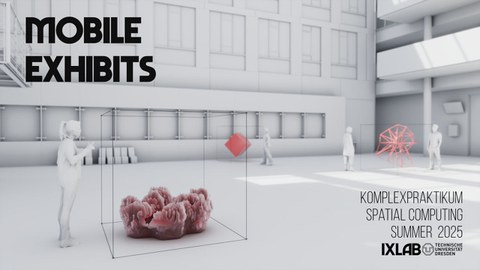Mobile Exhibits
The ‘//DataSpaces’ exhibition has been dismantled at the Andreas Pfitzmann Building, but it continues its journey and is being continuously developed. Existing exhibits are being revised in terms of content, and new research projects are being added as interactive stations. The complex internship focuses on research topics from Synosys, Chair of Industrial Design Engineering, the Office for Academic Heritage, Scientific and Art Collections and the IXLab.
As part of the internship, participants develop exhibits to bring these projects and topics to life in a variety of ways. The design possibilities range from screen-based stations to haptic-reactive objects.
The development process is accompanied by excursions and lectures. The aim is to develop functional exhibits for the exhibition.
Braitenberg Vehicles
by Utku Alkan, Jakub Gawroński and Hannes Reinhold
© IXlab@TUD
The Braitenberg Vehicles Interactive Exhibit brings so called Braitenberg Vehicles to life through a combination of physical interaction and real-time digital simulation. Inspired by Valentino Braitenberg’s thought experiments in synthetic psychology, the exhibit enables users to physically construct behavioral logic using sensors and wires, which is immediately mirrored in a simulated environment built with Unity. The hardware component consists of RFID-based sensor placement detection and a custom cable connection interface, which transmits data wirelessly to the software side. The simulation models realistic vehicle motion using Unity’s physics system, with cars reacting to light stimuli based on user-defined wiring. The result is an open-ended sandbox where users can explore emergent behaviors such as fear, aggression, and curiosity.
Heart of Dresden
by Florian Demmler, Jannes Rudnick and Sayandip Srimani
© IXlab@TUD
The motivation behind the "Heart of Dresden" project is to create a visually compelling and interactive way to experience the rhythm of a city. Dresden, like any urban environment, is a complex system—its daily life pulses with the movement and activity of its people. Our goal was to make this invisible rhythm visible, by showing a pulsating heart that reflects the ebb and flow of urban life.
The "heart" in this context is a dynamic cartogram: a map of Dresden whose districts expand and contract in real time, based on publicly available data about how busy each area is throughout the day. By leveraging this data, we aim to provide insight into the complex interplay of activity across the city, revealing patterns and hotspots that might otherwise go unnoticed. This approach not only highlights the vibrancy of Dresden but also demonstrates how data can be used to tell the story of a living, breathing city.
Dresden Research Landscape
by Anand Rajkumar Patil, Muhammad Hassaan Ibrahim and Georg Benedikt Grieger
© IXlab@TUD
The Dresden Research Landscape project turns TU Dresden’s internal publication data into an interactive, ring-shaped map that spotlights how its schools, faculties and chairs collaborate academically. By arranging units in concentric circles and letting users filter with a simple hardware dial as well as on the touch screen, the visualization makes patterns of co-authorship and cross-faculty teamwork immediately visible to experts and visitors alike.
Women in Computer Science
by Sajid Ali, Markus Forbrig and Ludwig Koch
© IXlab@TUD
This project explores the role of women in computer science. An interactive exhibit with simple mini-games was created to help visitors learn about women’s achievements in the field. Visitors can read biographies and engage with games linked to real inventions. For instance, one game allows users to program an ARM chip, while another demonstrates how Margaret Hamilton’s work contributed to the moon landing. The exhibit is designed to make learning accessible and engaging. Its goal is to highlight both the impact of these women and the significance of their contributions, while encouraging reflection on the importance of diversity in computer science.
Supervision
Brian Eschrich
Robert Fischer
Isin Kosemen
Ben F. Maier
Monika Reich
Jun.Prof. Matthew McGinity

